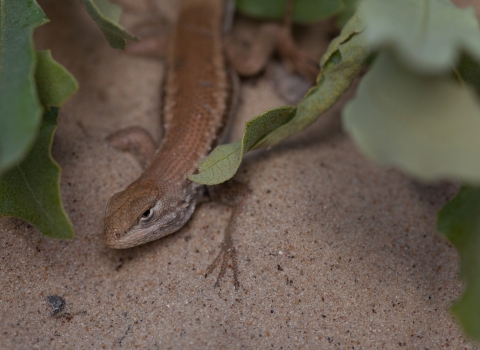WASHINGTON – The U.S. Fish and Wildlife Service today announced $10 million in fiscal year 2023 funds from President Biden’s Bipartisan Infrastructure Law Bipartisan Infrastructure Law
The Bipartisan Infrastructure Law (BIL) is a once-in-a-generation investment in the nation’s infrastructure and economic competitiveness. We were directly appropriated $455 million over five years in BIL funds for programs related to the President’s America the Beautiful initiative.
Learn more about Bipartisan Infrastructure Law to support over 50 projects in western states to restore and conserve strategic areas within the sagebrush ecosystem. These projects will combat invasive grasses and wildfire, reduce encroaching conifers, safeguard precious water resources for neighboring communities and wildlife, and promote community and economic sustainability.
“Sagebrush country, which is a national treasure, supports American agriculture, outdoor recreation, and hundreds of species that live nowhere else in the world,” said Service Director Martha Williams. “This ecosystem serves as the lifeblood for many rural and Tribal communities in the West. We are proud of the work we were able to accomplish last year through the first round of Bipartisan Infrastructure Law funding, and look forward to continuing collaborative efforts to conserve the sagebrush ecosystem and the significant biological, cultural and economic resources it supports.”
Spanning over 175 million acres, sagebrush country contains biological, cultural and economic resources of national significance. It is home to more than 350 species across the West, including pronghorn, elk, mule deer and greater sage grouse. America’s sagebrush ecosystem is the largest contiguous ecotype in the U. S., comprising one-third of the land mass of the lower 48 states.
Through the Bipartisan Infrastructure Law, the U.S. Fish and Wildlife Service was appropriated $10 million per year for five years, to expand work with partners to conserve the sagebrush ecosystem. Projects are helping to create good-paying jobs that strengthen local economies, investing in disadvantaged communities consistent with the President’s Justice 40 initiative, and furthering the strong working relationships between the Department, states and Tribes in these landscapes.
Examples of fiscal year 2023 projects include
Improving Climate Resilience of Sagebrush Ecosystem Communities in the Great Basin (Nev.), $405,000 in 2022 / $305,000 in 2023 - This is a multifaceted habitat restoration project that focuses on habitat restoration within Smith Valley west of Ely, Nevada. Consisting of mountain brush communities with a multitude of springs and seeps, this area is important for sage-grouse and other sagebrush-dependent species. Primary project activities include hand-thinning pinyon-juniper (fiscal year 2022 funds) and spring protection through fencing (fiscal year 2023 funds).
Bi-State Sagebrush Ecosystem Enhancement (Calif.), $250,000 – This project will enhance vegetation communities in the sagebrush ecosystem and focus on protecting and restoring wetlands and mesic habitats. Activities to be funded under this proposal include grazing management, addressing conifer encroachment, and mesic and riparian riparian
Definition of riparian habitat or riparian areas.
Learn more about riparian area enhancement to slow and disperse water flows and capture sediment which will restore altered hydrology.
Columbia Basin Pygmy Rabbit Recovery (Wash.), $209,100 – This project will propagate and release pygmy rabbits (listed as endangered under the ESA and by the state), assist landowners with habitat restoration, and enroll up to 25,000 acres of private land into Safe Harbor Agreements.
Pre- and post-treatment Impacts of Japanese Brome Treatment on Pollinators in Sagebrush Rangeland (Mont.), $70,000 - Japanese brome infestations are present within sagebrush core and growth areas of the Charles M. Russell National Wildlife Refuge. Herbicidal treatment sites will be paired with untreated Japanese brome invaded sagebrush areas and sagebrush areas with native dominated understory to determine effectiveness of restoration efforts and non-target impacts of the treatments. This work will complement ongoing work on the response of sagebrush obligate songbirds to invasive annual grass treatments.
See a full list of fiscal year 2023 projects on our Sagebrush Conservation website.
The Service is committed to working with local communities, state and federal agencies, Tribes, conservation groups and private sector partners to ensure they have the tools they need to conserve these important areas. Sagebrush funding is allocated to existing and new projects based on priorities established by the Service’s Sagebrush Ecosystem Team (SET) and partners, including the Western Association of Fish and Wildlife Agencies (WAFWA). The SET, WAFWA and others are employing a collaborative approach to defend and grow intact, functioning sagebrush geographies and mitigate the primary threats to sagebrush ecological health, namely invasive grasses and wildfire, drought and encroaching conifers. By anchoring conservation in these areas, the Service and its partners can focus on working to restore degraded lands and habitat through the “Defend the Core, Grow the Core” approach endorsed by the Western Governors Association.
These projects will help support the America the Beautiful initiative to conserve, connect and restore our nation’s lands, waters and wildlife.
– FWS –
The U.S. Fish and Wildlife Service works with others to conserve, protect and enhance fish, wildlife, plants and their habitats for the continuing benefit of the American people. For more information, visit www.fws.gov and connect with us on social media: Facebook, Instagram, Twitter, LinkedIn, Flickr and YouTube.



